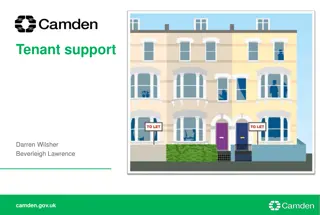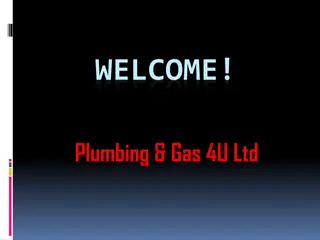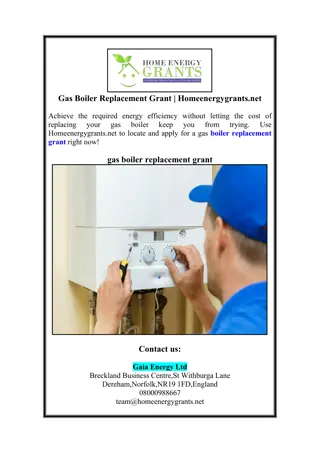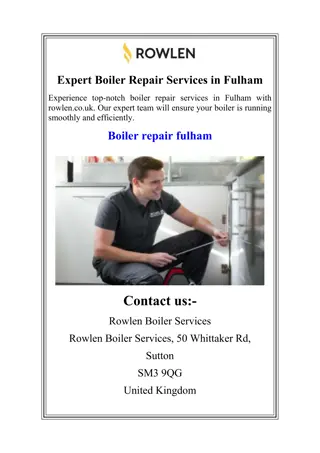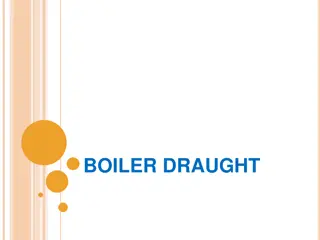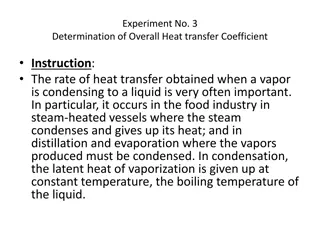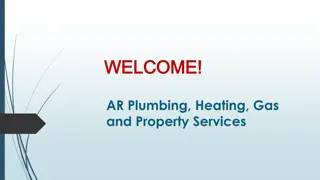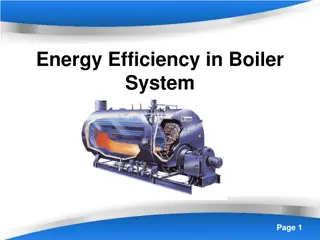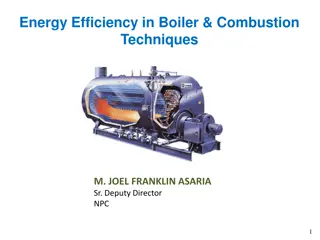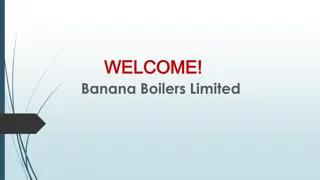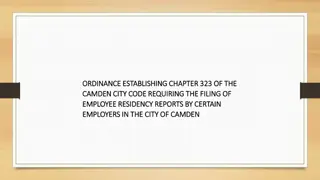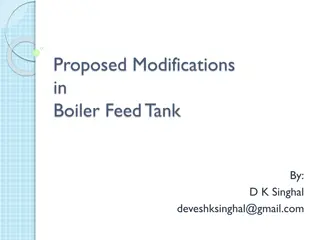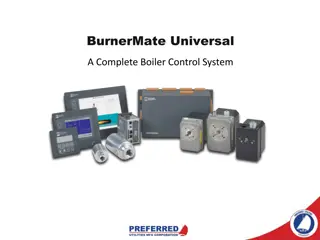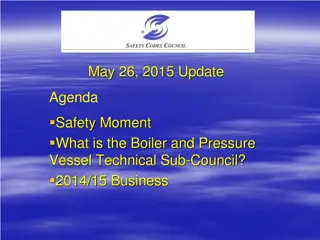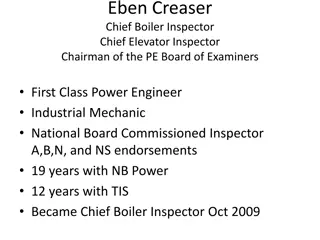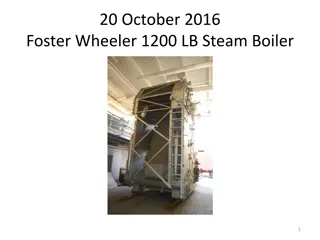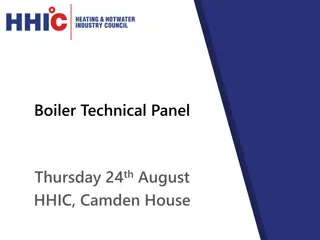HHIC Boiler Technical Panel Meeting - Tuesday 14th May at Camden House
The HHIC Boiler Technical Panel Meeting took place on Tuesday 14th May at Camden House. The meeting covered various topics including competition regulations, updates on ongoing matters, and discussions on key industry issues like transforming heating solutions and direct electric heating systems. Participants were reminded to comply with The Competition Act and avoid anti-competitive discussions. Apologies were received from several members, and actions were assigned for follow-up on specific agenda items. The meeting aimed to promote collaboration and exchange of information among industry professionals.
Download Presentation

Please find below an Image/Link to download the presentation.
The content on the website is provided AS IS for your information and personal use only. It may not be sold, licensed, or shared on other websites without obtaining consent from the author.If you encounter any issues during the download, it is possible that the publisher has removed the file from their server.
You are allowed to download the files provided on this website for personal or commercial use, subject to the condition that they are used lawfully. All files are the property of their respective owners.
The content on the website is provided AS IS for your information and personal use only. It may not be sold, licensed, or shared on other websites without obtaining consent from the author.
E N D
Presentation Transcript
HHIC Boiler Technical Panel meeting Tuesday 14thMay, Camden House, CV8 1TH
1. Welcome and Apologies Apologies received from: Jeff House Baxi, Sean Keleher Atag, Christian Engelke Viessmann, Louis Pickersgill Ravenheat, Alister Maclachlan Vokera, Steve Sutton - HHIC
2. The Competition Act Members are reminded of the requirements of The Competition Act: As a reputable trade association, HHIC s meetings must comply with the requirements of The Competition Act. This means that we must avoid any discussion that could be construed as being anti-competitive and in particular there must be no discussion about pricing of products and services. By attending this meeting and having your names included in the minutes, all participants confirm that they agree to comply with this policy.
3. Matters arising 16thJanuary 1) BEIS Transforming Heating document - ACTION: JN to liaise with Isaac and look to circulate an initial draft response around late January, to allow members some time to consider and refine (if needed) before the BEIS deadline of 22nd February - COMPLETE 2) Appliance packaging NM to update HHIC Installer Committee group on 11TP feedback - COMPLETE 3) CR 1404 (Nox calculation) and EcoTest - There is no proposed or active work item to revise the TR to a EN, but it was said that the current Ecotest work (round-robin testing) may inform necessary changes to the TR. ACTION: HHIC to circulate latest Ecotest information COMPLETE (latest update 2ndMay from Steve Sutton) 4) WEEE 2 HHIC to chase Environment Agency COMPLETE, covered by agenda
3. Matters arising 16thJanuary 5) Direct electric heating solutions (London Plan): GLA energy assessment guidance on preparing energy assessments as part of planning applications (October 2018): Direct electric heating will not be accepted in the majority of cases as it will not provide any on-site carbon savings in line with the energy hierarchy and it is likely to result in higher energy bills. Direct electric systems are also not compatible with connection to district heating networks 6) SAP 10 HHIC to circulate full set of SAP slides, presented at meeting with BEIS late 2018 - COMPLETE Stewart (Clements HHIC Director) to chase Katy Read (BEIS) for an update on latest BEIS thinking regarding monthly calculation proposal, and other concerns expressed ? HHIC to source document believed to have been provided by BRE, supporting their rationale for the carbon factor change to electricity ?
3. Matters arising 16thJanuary 7) Gas work on boilers - EH and SK elaborated on this, EH advising that taking a tool to a gas boiler or performing any kind of work on the appliance, required a registered gas engineer, SK commenting that there were two Gas Safe technical bulletins, TB 014 and TB 043, which supported this view, including that simply connecting the boiler flow and return pipes was a job for a registered gas engineer alone. ACTION: NM to circulate remains open 8) BEIS commissioned review of UK boiler market (ICF consultancy) ACTION: NM to circulate document post-meeting - COMPLETE 9) Benchmark - The group reviewed the working draft of changes to the boiler documentation (tabled), and EH pointed out that some of the wording on the front page could be construed as anti-competitive, i.e. that a collective stance on warranty management had been taken. ACTION: NM to revisit with working group, and circulate document for members to review in more detail, and feed back on COMPLETE, covered by agenda
3. Matters arising 16thJanuary 10) Boiler run hours - It was agreed that the action for HHIC should be to write out to 11TP members, asking for feedback on whether they agree with adopting, or at least investigating the principle further, and if so, what the views are on average use run hours (e.g. 1600 hours). ACTION: HHIC COMPLETE 11) Ban on use of combustible materials in external walls of high-rise dwellings (>18m) - The group noted that the change to Building Regulations (& approved document B) implemented this ban for new build and repurposing of an existing building, but were unclear what the specific mechanism for ensuring that refurbishment (e.g. recladding) projects did not utilise combustible materials. ACTION: HHIC to make enquiry and update COMPLETE, covered by agenda 12) Flue gas analysis and changing gas quality - members raised questions as to what impact this could have upon combustion measurement accuracy. It was noted that a similar conversation, around CO2 content of distributed natural gas, had already begun with these parties, and it was requested that HHIC modify the conversation to also consider Wobbe Index. ACTION: NM to write to HHIC member companies (FGA manufacturers) COMPLETE, covered by agenda
4. WEEE 2 Agreed HHIC position was that boilers are out of scope However, updated guidance published by The Environment Agency (EA) (October 2018) now details one example of EEE as: gas boiler - where they rely on electricity to work properly This wording is mirrored in a letter to HHIC from Louisa Hatton (EA), received 19thFebruary, and which also states, in response to our previous communication quoting earlier advice given by the EA which had helped us form our out of scope view: You quote a number of pieces of advice and guidance in your letter, however, these are now out of date and have been superseded by updated regulations and guidance. I appreciate that you want to give the best advice to your members and I would like to help you achieve that. The UK environment agencies are launching an "EEE Scope Panel" which will review products with a number of agency and industry representatives. Please let me know if you would like to submit any specific products for the panel to discuss. We are happy to discuss generic products if companies need anonymity
5. ErP review of Lot 1 & Lot 2 Key talking points? Rescaling of label classes, which would mean that gas condensing boilers would be, at best, class C For the package label (? Effect on ErP appliance value), changing the factor F(1) from -3% to -8%. (This is a factor taken from the calculated space heater efficiency before adding the effect of controls from the temperature control classes.) Effectively a 5% reduction in the space heater efficiency The addition of flue gas heat recovery into the package label A 20% energy efficiency bonus for hydrogen ready boilers leading to an A+ rating for a single boiler, and then after 2 years make H2-ready mandatory
5. ErP review of Lot 1 & Lot 2 A special energy efficiency allowance, e.g. 20%, for boilers that are placed on the market exclusively to handle biogas Introducing proposals for third party verification of all space heater types (in particular, extending it to cover heat pumps) last known EHI position: under review, previously advised that TPCA should not be extended to other parameters being considered, e.g. CO, hydrocarbons . Changing heater testing to account for oversizing of heating load and reassessing system return temperatures
Eco Test Project The last Steering Committee meeting of the Ecotest project took place on 3 April 2019. The main results presented at the meeting are as follows: From the general point of view there have been a long an intensive discussion with Mr Kemna on the outcome of the Ecotest and his recommendations in his draft report on Lot 1 and 2; It was clearly pointed out, that the standard deviation or tolerances out of the Ecotest are not equal to that tolerances for the market surveillance he is indicating. The min / max range is only the range in which the test houses are measuring the values. This has nothing to do with the necessary range of tolerances VHK is looking for; All round robin tests of the various Work Packages see following table are finalised and the work package reports are being finalised. Improvements of the procedures from standards project will result in better reproducibility between the laboratories in the future, but the project has also pointed out additional potential actions outside the CEN scope that will also contribute to improving the situation.
Gas Boiler Results The Max-Min values for full and part load efficiency are in general in the range 2 to 4%; where the results at Part load has higher differences, which was expected; NOx emissions: the difference on weighted NOx emissions is much larger than the market surveillance tolerance for the gas boiler. Therefore, an absolute value for the tolerance shall be considered! large deviations of standby losses and auxiliary energy; however, the impact on seasonal efficiency is very low; Hot water efficiency of storage technologies shows to be less accurate than for instantaneous technology.
Oil Boiler Results Results on fuel oil boiler: The Max-Min values for full and part load efficiency are in general in the range 2 to 4%; where the results as not expected at full load has higher differences: because of the dynamic testing conditions!? NOx emissions: the differences are below the market surveillance tolerance, but the emission level is much higher as allowed; Verbal reasoning at SC: old boiler before the coming into force of the NOx emission level Therefore, an absolute value for the tolerance shall be considered! Big difference between standby loss methods; NBs/Accreditation authorities to ensure labs follow procedures in standards; Extended testing (more cycles beyond 3) makes little difference for full load; Cross check with indirect method to avoid major errors in full load test; Large deviations of standby losses and auxiliary energy; however, the impact on seasonal efficiency is very low. Results on mCHP: Results are only available from two labs so far; The difference on weighted NOx emissions is much larger than the market surveillance tolerance! Low-emission appliances show more relative variations on NOx measured; Large deviations of standby losses and auxiliary electrical consumption; however, the impact on seasonal efficiency is very low; Therefore, an absolute value for the tolerance shall be considered!
Heat Pump/Solar Results Tested appliances: RRT 1: Air / Water Heat Pump for space heating; RTT 2: W/W 2-stage heat pump for space heating; RRT 3: In Door HP for DHW with tank; RRT 4: Hybrid heat pump (oA/G) for space heating; All labs showed a very high level of media of condition and measurement accuracy all test conditions were within the permissible deviations with mostly significant margins; Very good reproducibility of the results. Results on Solar: Interpretation of the measurement results by the labs are causing problems and misinterpretations; The readability of the regulation and standard requirements should be improved to be clear; Scope of the standards should be improved; Real testing conditions should be integrated; Propagation of Solcal and Soltherm.
6. Household appliances / ancillary devices (e.g. circulating pumps) & type AC RCD s Query to HHIC from within the membership: I am aware that some new circulators are coming into the market place, and could also be used integral to some appliances, that have specific design changes that may impact electrical protection in UK households, hence the reason for my email. Please take this email as an enquiry to establish facts, and not a safety alert of any kind. It has been suggested that the new design circulators (pumps) have the potential to introduce DC feedback onto the electrical supply. I believe that the circulator manufacturer s instructions may stipulate a Type A or B RCD would be required. These (type A or B) RCDs are electrical safety devices that are resilient to DC effects. However I believe that the majority of UK homes will have Type AC RCD s. Type AC RCD s (general use) have been required in the UK for various circuits as additional protection for many years now (25+). These offer protection for AC loads only, with no DC fault protection, indeed I understand that they may render the AC (general use) RCD inoperable where DC voltage is superimposed onto the circuit ..
6. Household appliances / ancillary devices (e.g. circulating pumps) & type AC RCD s So in summary my query is to try and ascertain if the above is the case, and if any of the makers technical teams, or industry bodies, have any insight that could help with understanding, as my concern if the above is the case, and the existing installation has a Type AC (general use) RCD installed on the circuit supplying the heating system and we then install a circulator (or an appliance with an integral circulator) of this nature, that the existing electrical installation protection for the property may be compromised. To achieve safe installation would require an upgrade of the electrical installation with a replacement of any existing AC (general use) RCD in the circuit with a Type A device, this would likely need an electrician to fit it, and to ensure household protection is maintained would need to be very clear in any installation instructions. If this is something you feel we (industry) could understand through the group it would be useful, unless you can think of another body that represents the circulator manufacturers
Integrated circulators - update Amendments to Regulation (EC) 641/2009: the exemption for integrated circulators provided as a spare part for existing boilers is extended by two more years to ensure that installed boilers with a defective circulator can be repaired within their technical lifetime (article 11 and recital 32); it means that integrated circulators, placed on the market as replacement for identical circulators integrated in products and placed on the market no later than 1 August 2015, will need to comply with the minimum Ecodesign requirements from 1 January 2022; Next steps By end May 2019: the Council and the European Parliament have the right to object to the whole text (i.e. no amendment possible); Summer 2019: final adoption of the text by the European Commission and publication in EU OJ; 1 July 2021: application date of the revised Regulation, except for article 7 on circumvention and software updates and article 11 on integrated circulators that will apply from its entry into force.
Integrated circulators - update EHI update; 29thMarch: On 26 March 2019, the Council published a document informing that Member States have not submitted any comment to the final draft Ecodesign Regulation for electric motors and variable speed drives, as well as integrated circulators. It means that the 'Coreper', composed of each country's deputy permanent representatives, will recommend the Council not oppose to the draft measure. Next steps 3 April 2019: the Coreper will recommend the Council to confirm that there are no grounds for opposing the draft Ecodesign Regulation; By end May 2019: the Council to confirm that there is no ground to oppose the draft measure; the European Parliament has the right to object to the draft measure.
7. Indicative Part L review timeline 4.2.1 Approved Documents L (Conservation of fuel and power), F (ventilation) and overheating The time table is as follows: Consultation starts in July 2019 Completion aimed for February 2020 Published in March 2020 Legal enforcement from October 2020. HHIC are confirmed as participants in the TWG for both England and Wales, respectively The Welsh Govt. has already held one meeting, with the next in July The kick-off meeting for England ( domestic WG) is on May 13th
7. Part L reviews & pre-consultations (England; Wales) If possible, will look to update with more information after the meeting for England on May 13th(day before 11TP). If not will talk through.
8. SAP specifications & FGHR with regular boilers
9. SAPIF HEATING AND HOTWATER
Working Groups #1 Domestic Hot Water (DHW) Steven Sutton (HHIC) and Jeff House (Building Alliance) #2 Smart Controls, technologies & tarriffs Colin Timmins (BEAMA) #3 Home energy storage (heat and electricity) Gill Kelleher (SPECIFC) and Hanae Chauvaud de Rochefort (Association for Decentralised Energy) #4 Overheating incl prevention & cooling Dave Bush (BBSA) and Phil Brown (GGF) #5 Ventilation and Indoor Air Quality (IAQ) Nick Howlett (FETA) and Adrian Regueira-Lopez (BEAMA) End
Heating & Hotwater Technology Categories Technology Methodology in SAP 10.0 Category in PCDB Yes Comment: Separate sub-category for heat pump compatible cylinders may be required to reflect heat coil transfer rates and performance. Flexibility and addressable storage significant potential No Hot Water Cylinders Yes Comment: Flexibility and addressable storage significant potential No Thermal Stores and Combined Primary Storage Units Yes Comment: Methodology well established although any changes to treatment of FGHR would impact on boilers with inbuilt devices Yes Combi Boiler Yes Comment: Methodology may require attention to properly reflect difference between stored and non-stored design Yes Flue Gas Heat Recovery (FGHR) Yes Comment: Methodology well established Yes Heat Pumps (hydronic system feeding cylinder / store) Yes Comment: Further innovation linked to MVHR and potential comfort cooling integration Yes Heat Pumps (exhaust air separate or close coupled cylinder / store) No Comment: Methodology in development No Heat Pumps (hybrid) Yes Methodology for existing appliance types well represented through PAS 67, note that innovative products in development together with "add-on" types which would lead toward hybrid implementation Yes Combined Heat and Power (all types, including engine, fuel cell and others)
Heating & Hotwater Technology Categories Yes Comment: Current methodology for WWHRS needs refinement. The idea of dynamic modelling could be crucial. Showering is likely to be one of, if not the highest peak demand for domestic energy. Methodology for SAP 11 should be considering this, and recognising the technology that improves energy efficiency for DHW. This will reduce the chance of actually having to use additional backups that are more carbon intensive, similar to the ideas of the current London Plan (Lean, Clean, Green). Consideration also needs to be give for the relationship between WWHRS and other technologies. E.g. Size of domestic hot water storage required when WWHRS is present (reducing standing heat losses), or size of combination boiler required to meet DHW demand, reduction of load on Heat pumps, HIU's and heat networks. Ontario and Manitoba in Canada (over 30% of all new builds) since 2017 have made WWHRS mandatory, due to the impact it can have on DHW loads in domestic dwellings. California is now in the process of doing the same. Yes Waste Water Heat Recovery (WWHR) Yes Comment: General principle of heat networks acknowledged within SAP but needs more definition and detail, CIBSE CP1 offers good guidance. Performance data for HIU's showing significant spread in market so default value treatment not appropriate. Dynamic model could include diversity assessment for central plant and efficiency benefit of such. No Heat Interface Units (HIU) Yes Comment: Possible innovation around PVT and collector design No Solar Thermal Yes Comment: As above ref. PVT. How the generated energy will be used is the key issue for SAP with grid interactivity influencing self consumption. No Solar Photovoltaic (PV) Yes Comment: Includes electric showers No Instantaneous Point of Use Water Heaters (single and multipoint) Yes Comment: currently commonplace in commercial applications, may become more widespread with potential future divergence from central hydronic heat / DHW system No Storage Point of Use Water Heaters (single and multipoint)
Next Steps SAPIF H & HW members have been requested to review their technology areas Define technology category templates Main Areas Identified so far: Improvements for Domestic Hot water storage Method for Heat Interface Units Further actions Refine technology matrix
10. Heating system filters best practice, or a requirement? BS 7593:2019; Code of practice for the preparation, commissioning and maintenance of domestic central heating and cooling water systems is expected to be published imminently, and amongst other changes, contains a new clause, 8, on system filters The British Standard , as the title confirms, is actually a code of practice , and takes the form of recommendations which should (this being the operative word) be followed Introductory text in the standard makes clear that the standard is not a specification, and should not be quoted as such New clause 8 seen on next slide
10. Heating system filters best practice, or a requirement?
10. Heating system filters best practice, or a requirement? BS 7593 introduction:
10. Heating system filters best practice, or a requirement? Domestic Building Services Compliance Guide:
10. Heating system filters best practice, or a requirement? Domestic Building Services Compliance Guide:
10. Heating system filters best practice, or a requirement? Domestic Building Services Compliance Guide:
10. Building Regulation guidance Approved Documents (Building Regulation) FIA meeting update(Feb 28th): consideration to be given to whether a specific overarching process only guidance document to Building Regulation should be produced, or as exists currently, process remain combined with the technical requirements in the individual Approved Documents (AD s). Short-term action to create a searchable PDF of all AD s. Short term part J changes likely to remain on hold, as it is felt the key functional requirements remain sound. The AD reviews are broken down by domestic and non-domestic, whereas Part J is broken down by fuel type. Long term J could be revised focusing on the functional requirements, and then breaking down each section by fuel specifics Text that is simply useful advice could disappear from the AD s if not intrinsic to meeting the functional technical requirements, MHCLG feel some statutory guidance is needed, but some parts of industry do not, and there is a balance to be struck
11. Ban on use of combustible materials in external walls of high rise dwellings Impact upon boiler installations in England: December 2018 changes to the Building Regulations (England) came into effect on 21st December, and have implemented new criteria for all materials forming part of the external wall in high rise residential dwellings (>18m), bar specific, listed exemptions. The ban limits materials to products achieving a European Classification of Class A1 or A2-s1,d0 when tested in accordance with BS EN 13501-1 :2007+A1:2009 Alongside new dwellings constructed, MHCLG have confirmed that building work being undertaken, e.g. the installation of a notifiable replacement gas boiler in such dwellings, will trigger the requirement to ensure all works undertaken are in compliance with current Building Regulations
11. Ban on use of combustible materials in external walls of high rise dwellings New definition of external wall inserted into Building Regulations now captures building penetrations, e.g. flues, boiler PRV pipes and condensate disposal pipe runs, not merely construction elements: (6) In these Regulations (a)any reference to an external wall of a building includes a reference to (i)anything located within any space forming part of the wall; (ii)any decoration or other finish applied to any external (but not internal) surface forming part of the wall; (iii)any windows and doors in the wall; and (iv)any part of a roof pitched at an angle of more than 70 degrees to the horizontal if that part of the roof adjoins a space within the building to which persons have access, but not access only for the purpose of carrying out repairs or maintenance
11. Ban on use of combustible materials in external walls of high rise dwellings HHIC meeting with MHCLG on 11th April, actions agreed: MHCLG clarified that the effect of the 2018 amendment is that when a gas boiler is replaced and the flue becomes part of the external wall in a relevant building then the flue components that pass through the external wall are caught by the ban on combustible materials. HHIC said that flue products for gas condensing boilers tend to be plastic as the condensate was slightly acidic/corrosive and such products were not readily available they considered an all metallic solution non- combustible solution could be engineered but this would need to be certified under the construction products regulations and so would take some time to bring to market. HHIC to pursue this with manufacturers and advise on timescales. As well as any CPR-certification required for the standalone flue product, a change in flue material/construction may effect a material change to the combined boiler/flue certification under The Gas Appliances Regulation , and so may similarly require additional testing and recertification, hence feeding into the time to bring to market . being actively explored with boiler manufacturers MHCLG to explore with legal and ministers the possibility of a period of grace/relaxation. - ongoing MHCLG and HHIC to share data on the number of dwellings in relevant buildings and number of boiler sales to extrapolate the number of gas boiler/flue replacements affected and determine the market size/demand - We have calculated that there are probably around 300,000 boilers in situ in high rises. This is based on using the English Housing Survey numbers of number of High Rises and then the number that have no gas connection and then being a bit more conservative. From this we estimate that there are around 20k replacements per annum. MHCLG to investigate with legal the correct interpretation (i.e. permissibility) of boiler plume management kits, if to be mounted to the external walls of these dwelling types - ongoing
12. PAS 2035 / Trustmark HHIC met with BSI and the technical author of PAS 2035, Peter Rickaby, on 2nd April to raise our concerns. This followed circulation to select HHIC/EUA staff of the latest draft of PAS 2035, subject to NDA s being signed, and which has moved on from the draft for public consultation. There seems to now be some acceptance that the heating industry has been overlooked throughout the drafting process, i.e. no real representation of domestic heat (e.g. boilers) on the steering group. BSI have agreed to involve HHIC in future steering group meetings, as members, but stress publication deadlines will be adhered to. There may be no formal reconvening of the group until 19 months post publication (see Trustmark timeline slide). Technical/editorial comments from HHIC were invited on the draft, and these were submitted by the agreed timelines. We await an update and/or publication of the draft
12. PAS 2035 / Trustmark It is important to emphasise that a consultation of linking PAS 2035 to ECO work is planned, and that despite the ECO boiler cap, we know BEIS are considering extending PAS 2035 to other areas, as best practice , so this could impact much more widely in time, e.g. housing association contracts etc.
13. Trustmark presentation to HHIC 23/04/2019
13. Hydrogen activity Hy4Heat (inc. PAS 4444) BSI are developing this PAS to support hydrogen appliance (WP4) certification under WP3. The initial scoping workshop has already been held, and Bob Walsh (ICOM consultant) appointed as technical author
13. Hydrogen activity HyDeploy H2 injection into the Keele network is due to start in August 2019 Will help inform HyDeploy 2, which is looking to build to a position where it can be demonstrated that pre-checks and monitoring are not required for a given H2NG blend CEN-CENELEC TC6 ( Hydrogen in energy systems ) HHIC have joined WG1, which has an early task of developing a Hydrogen vocabulary document, with our initial interest being in defining residential appliances , alongside cross-cutting issues/terms
14. 4MS list of approved metal alloys; update on revision of Drinking Water Directive (DWD) Revision of Drinking Water Directive (DWD): The latest EHI briefing on this (6th March) details that the council have adopted a revised position on this. Importantly, it appears that the initial proposal to harmonise such requirements in conjunction with the Construction Products Regulation (CPR), has been dropped, and the approach advocated by HHIC and EHI is being progressed, this being realisation by amendment to the Drinking Water Directive itself (and through implementing acts).
14. 4MS list of approved metal alloys; update on revision of Drinking Water Directive (DWD) The UK drinking water regulators have written to water companies, and WRAS, with the following text being perhaps key content in the attachment circulated by HHIC: The UK Regulators recommend that the water companies (with the cooperation of WRAS) actively promote the use of metallic fittings that are made from alloys on the 4MS Common Composition List of low leaching metallic alloys There is a link to a list of these metal alloys in the document, and you will see that the regulators are open to comments and feedback on any practical considerations or difficulties a move to embrace this might bring. https://www.umweltbundesamt.de/en/topics/water/drinking-water/distributing- drinking-water/approval-harmonization-4ms-initiative) We would suggest that members review the list, in conjunction with your products, and advise of any thoughts or concerns you may have ASAP.
15. Benchmark The Delta EE review concluded in March, with the production of a final report, and on which a high level overview was provided by Delta EE Director Jon Slowe at the HHIC annual members lunch Digitalisation , and the increased potential of a truly online Benchmark remain key feedback themes from stakeholders, and HHIC are now considering options, and how best to progress this Benchmark gas boiler form revision: Some minor editorial points still to resolve Additions/changes since last update to group (working draft): Reference to BS 7593 on service record (inhibitor testing in line with BS 7593) Flue integrity check to be included in commissioning section Run hours not expected to be included as it is not currently standard industry practice and many boilers do not lend themselves to it at this moment in time


